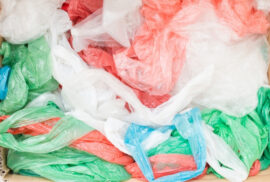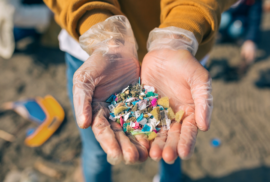Managing toxic relationships with Dr. Rediske

Who’s up for a little thought experiment? Say a new system was designed that produces energy cheaply and easily.
There is already a lot of infrastructure in place to produce this energy, but the process itself is pretty inefficient and wasteful.
The mostly organic source has to be burned for energy, producing tons of carbon dioxide. The waste products include mercury, arsenic and cadmium and are spread into our air, water and land. Also, it renders fish from all inland lakes inedible.
Professor Emeritus at Grand Valley State University’s Annis Water Resources Institute, Dr. Rick Rediske, proposes this list of pros and cons to highlight the obscenity of coal-fired power stations.
The costs of coal far outweigh the benefits. For decades, fish from inland Michigan waters have been so intoxicated with methylmercury from coal plants that it has been ill-advised to eat them.
What are PFAS?
A far less-known chemical villain that you may or may not have heard of is PFAS. PFAS are Dr. Rediske’s primary area of expertise and an abbreviation with quite the history in Michigan.
Per- and polyfluoroalkyl substances (PFAS) are actually a group of similar substances that is made up of at least 10,000 individual compounds. PFAS are often used as a sort of resistant coating in manufacturing.
Unlike methylmercury, PFAS is not generally absorbed by fish in our waterways. Instead, the main concern for human exposure is through drinking water and contact from everyday products.
Exposure to PFAS has been linked to decreased birth weight, cancers and decreased response to vaccines—making them very dangerous to our communities and all Michiganders.
Dr. Rediske was on the cutting edge of PFAS research and consultation in the 1980s. The Wolverine World Wide tannery incident in the Rogue River led to Michigan establishing stricter-than-federal rules for PFAS.
“What really helped was something called Rule 57, it’s the administrative rule that allows Michigan to establish limits for toxic compounds. I was in the group that helped write that,” Rediske said. “It’s stood the test of time. It’s been around ever since the ‘80s. We were able to come up with a water quality standard before most states did that.”
PFAS TODAY
What worries Dr. Rediske today is the sheer number of products that still contain PFAS or are manufactured with closely related compounds.
“Lithium ion batteries have a PFAS-related compound in them. A recent study found that this compound is just as toxic as PFOS and PFOA,” Rediske said.
The study advocates for more lifecycle testing of these batteries—a sentiment Dr. Rediske echoes. “I think a lifecycle or cradle-to-grave analysis is really important with that. When you look at the manufacturing process; how much [of the compound] do you lose when you start using the battery? When you’re cleaning parts, how much gets washed off?”
These lithium batteries are integral to our current green energy processes.
“I’m concerned about the chemicals we’re embedding into our society–whether they come from traditionally ‘bad’ sources or advancements like green technology,” Rediske said. “I think it’s important to ask questions that help keep people safe.”

As we continue to make advancements in areas like green technology, it’s critical that we examine the costs and outputs of that energy production to ensure chemicals like PFAS don’t harm our communities.
“You can’t assume the due diligence has been done. That’s the thing that we’ve learned about PFAS—it shows up everywhere, including in some dental floss,” Rediske said. “When you look at food, water and products, you can still find high levels of PFAS in everyday living”
Our exposure to PFAS is an inevitability in the current landscape of product manufacturing. The umbrella of harmful PFAS compounds is ever-growing. Other countries are starting to regulate them as one large clade of chemicals to better protect against their proliferation.
So many products are laden with PFAS or PFAS-adjacent chemicals- and as luck would have it- they’re exactly what you wouldn’t want to include toxic chemicals: Dental floss, food wrappers, child car seats, baby clothes, mattresses, all products that would easily inoculate the average person and persons at increased risk.
At the moment, PFAS substances are not subject to the same regulations as other toxic pollutants.
These instances of PFAS remain because our protections and rulemaking around harmful PFAS substances are outdated. Just 15 words added to Part 31 of the Natural Resources and Environmental Protection Act in 2006 prevent our Department of Environment, Great Lakes, and Energy (EGLE) from advancing protections.
Our knowledge gained since 2006 about PFAS and PFAS related substances is not reflected in law because of those 15 words that keep Michiganders without the protections that their families deserve.
There is hope on the horizon, with Michigan’s senate voting in favor of a bill that would strike those 15 words and unlock the ability to better protect Michigan and its people.
Looking for some PFAS-free-product guidance? You can find it here and here.
Discover
Power environmental change today.
Your gift to the Michigan Environmental Council is a powerful investment in the air we breathe, our water and the places we love.
Sign up for environmental news & stories.
"*" indicates required fields




